3. Anti-Catholicism of Western Europe – which arose as a synthesis of the dualistic and pagan religions, heretical sects and Roman Catholics who were disgusted by some practices of the Papacy. The greatest contributors to this synthesis were undoubtedly the Cathars, who were dualists, and the Arians, while the anti-Catholic pagans, colliding with Catholicism generally, assumed either the position of dualists or of Arians, which is a well-known effect, articulated by “We preach Christ crucified, unto the Jews a stumbling block and unto the Greeks foolishness.” 1 Cor. 1:23.
The influence of iconoclasm on the emergence of Western civilization is due to the fact that, in 754, when the iconoclastic Council of Hieria, also known as the Headless Council or the Mock Council of Constantinople, was convened, Pope Stephen II quite reasonably assumed that the power of the iconoclastic Byzantine Emperor Constantine V was an anti-Christian power and refused to cooperate with it. Therefore, Pope Stephen II acted exactly as Anthony Khrapovitsky wanted Patriarch Tikhon to do in a similar circumstance many years later: he refused to cooperate with the anti-Christian power and committed an act of treason against the Byzantine emperor by becoming a vassal of the Frankish crown. Indeed, Franks were the only Orthodox Christian nation in the west, and their kingdom, led by King Pepin the Short, was the right place to look for help against the advancing armies of Arian - Lombards, especially considering that the Byzantine Emperor refused to help, pleading the necessity to fight a civil war with the iconophiles. As was typical in political Christianity, the Franks became Orthodox Christians in some sense by accident as Frankish King Clovis was baptized in 498, when the Orthodox were the Imperial power, while the Langobards and all the other nations of the West were baptized by the Empire when the Arians were ruling in Byzantium. So it is only natural that after Charlemagne defeated the Langobards in 772, and his establishment of the Papal state, popes became vassals of the Frankish crown and were doomed to make him emperor.
When the Empress Irina convened the Seventh Ecumenical Council in 787 in Nicaea, which ultimately condemned iconoclasm, the reason for the Pope’s change of homage disappeared, but the allegiance of the popes to the Frankish kings remained. Ironically, the allegedly illiterate heir to Pepin the Short, Charlemagne, well understood the inevitability of taking the title of Emperor, and the religious and political implications incumbent upon that title. In 794 he convened the Frankfurt Council, which established “Germanic theology” and condemned the veneration of icons formulated by the Seventh Ecumenical Council that ended the iconoclasm controversy in Byzantium, but the Frankfurt Council reduced the purpose of icons in the liturgy to an illustrative function, thus taking the iconoclastic position. Pope Stephen II (III) initially objected, but impressed by the military achievements, the Frankish kings obeyed and signed the proceedings of the Frankfurt Council, thus laying the foundation for the secularization of art in Western Europe and the transition from iconography to religious art. By the way, the notorious Filioque was also established as Western Christian dogma by the Frankfurt Council at the insistence of the future Emperor of the Holy Roman Empire, Charlemagne, in order to prevent the popes from switching allegiance and submitting themselves to the Byzantine Emperor again. Thus, the anti-Arian Filioque, which was considered quite Orthodox in Spain, became the cause for schism as soon as Civilization Christianity used it as an instrument to seize power over the Church. However, we must pay tribute to Pope Leo III, who refused to sign the Filioque, or affirm his own infallibility, in spite of the pressure coming from Charlemagne.
Thus we can see the appearance of two fundamentally different, directions of the development of Christian art. The historical dichotomy of Orthodox Christianity and Roman Catholicism, beginning in the year 800 A.D., reached its peak in 1202 during the Fourth Crusade, while in art this dichotomy began at about the same time, but reached its apogee in the 16th century. This discrepancy in timing is caused by the fact that Orthodox Christian art became ripe not in Byzantium, but in Russian iconography right after the Kulikov Battle, which was the beginning of the historic counter-attack of Orthodox Christian civilization against the political Christianity provoked by the Fourth Crusade. The comparison of two pieces of art, the Coronation of Charlemagne by Raphael, and the Empress Irene at the Seventh Ecumenical Council by Dionysius, enables one to see a most amazing correlation of the historic, spiritual and aesthetic development of culture. Indeed, the Coronation of Charlemagne caused a chain of events resulting in the Fourth Crusade and appears to be not only the historical, but also the spiritual antithesis of the Seventh Ecumenical Council, which not for nothing is called the “Triumph of Orthodoxy”. One can only wonder that these two aesthetically opposite works of art were created almost simultaneously by the two artistic archetypes of Roman Catholicism and Orthodox Christianity. It is amazing that these works both appeared to be an artistic look-back on one and the same historic process caused by two different events.
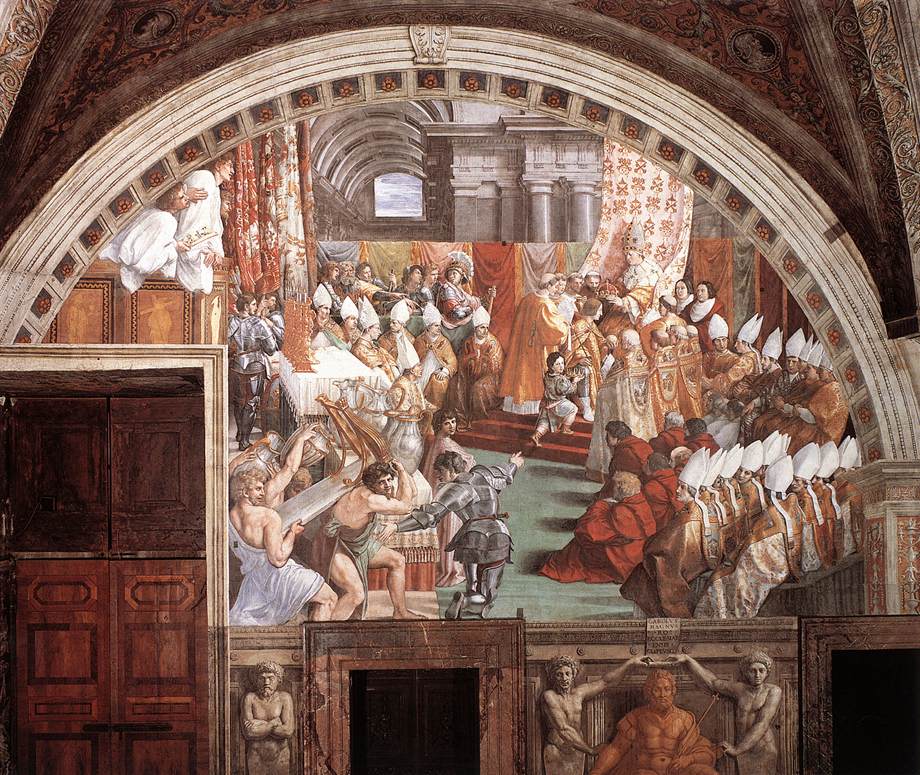 Coronation of Charlemagne. Workshop of Raphael Santi. Papal Palace, Vatican City. 1516 |  Empress Irina and her son at the Seventh Ecumenical Council. Frescoe by Dionysius. 16 Century |
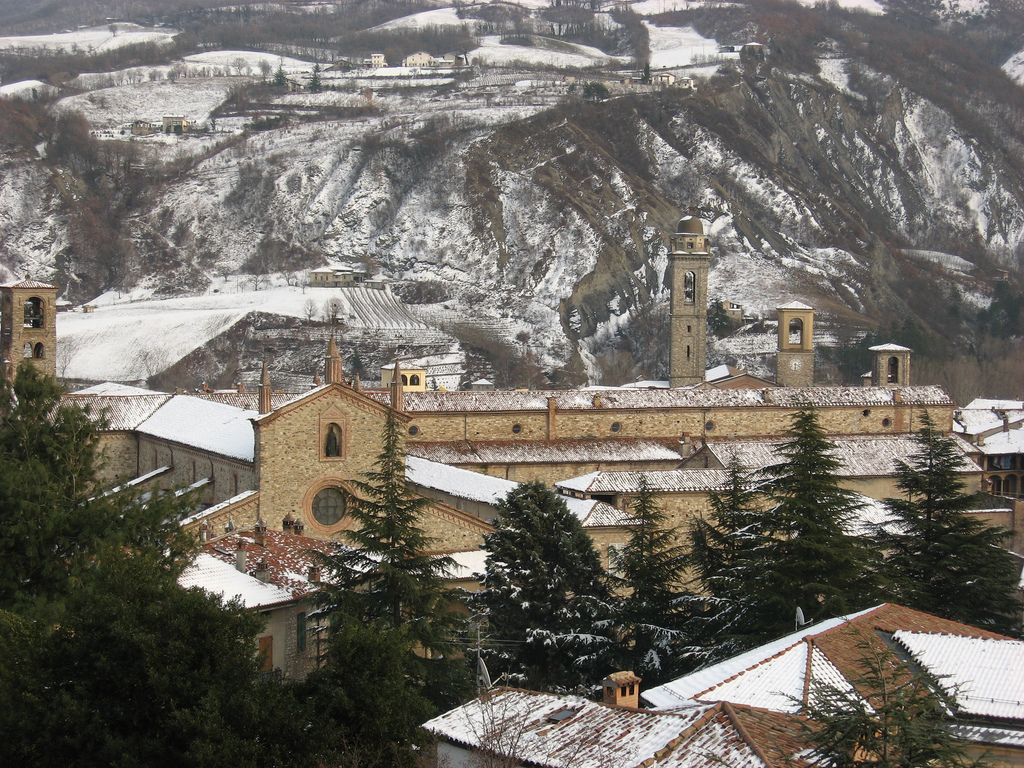 Bobboi Abbey, the Cathedral of St. Columban. | St. Columban. Fresco. Cathedral of Abbey Bobbio, 642 | 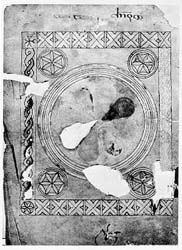 Cover page of "Chronicles" by Orosi. Scriptorium Bobbio. |
One can only guess how much progress Western Christianity could have made if the Orthodox Christian Irish missionaries from Bobbio, rather than the swords of Frankish warriors, had been successful in converting the Lombards and the Visigoths. For instance, as mentioned above, even before the Holy Roman Empire of the German nation was created, the followers of St. Patrick built a system of monasteries in Ireland and then throughout Europe. This enabled them not only to baptize their Celtic relatives, the Scots, but also, unlike the Welsh, who were succumbed by nationalism, send missionaries to the Germans tribes – the Angles and Saxons, who were their mortal enemies. In parallel with the Irish missionaries in Scotland and Northumbria, in the south of England in the kingdom of Kent, the envoy of the Pope, Augustine (later St. Augustine of Canterbury), created the Canterbury bishopric. These two traditions, the Irish and the Papal, in the specific conditions of the British Isles, were in constant competition with each other, but still more or less peacefully coexisted, resulting by the 7th century in a convent school in Kent where, in addition to theology, Latin and Greek, medicine and rhetoric were taught.
Meanwhile, in Northumbria, in the far north of England, Christianity was for a short while under the influence of Canterbury, but the Irish monastic tradition was quickly restored, and the culture of Northumbria went through a particularly flourishing period, which had a huge influence on the development of the culture in the British Isles that continues to this day. For example, one should remember the Gospel of Lindisfarne and the fact that according to legend, a cult figure of the Western world, King Arthur, is buried three kilometers from the abbey of Melrouz, which was built on the site of the abbey of St. Aydena, the Irish apostle to England. Furthermore, careful examination of the issue leads to the conclusion that Celtic Christianity never lost its connection with the Orthodoxy of St. Patrick.
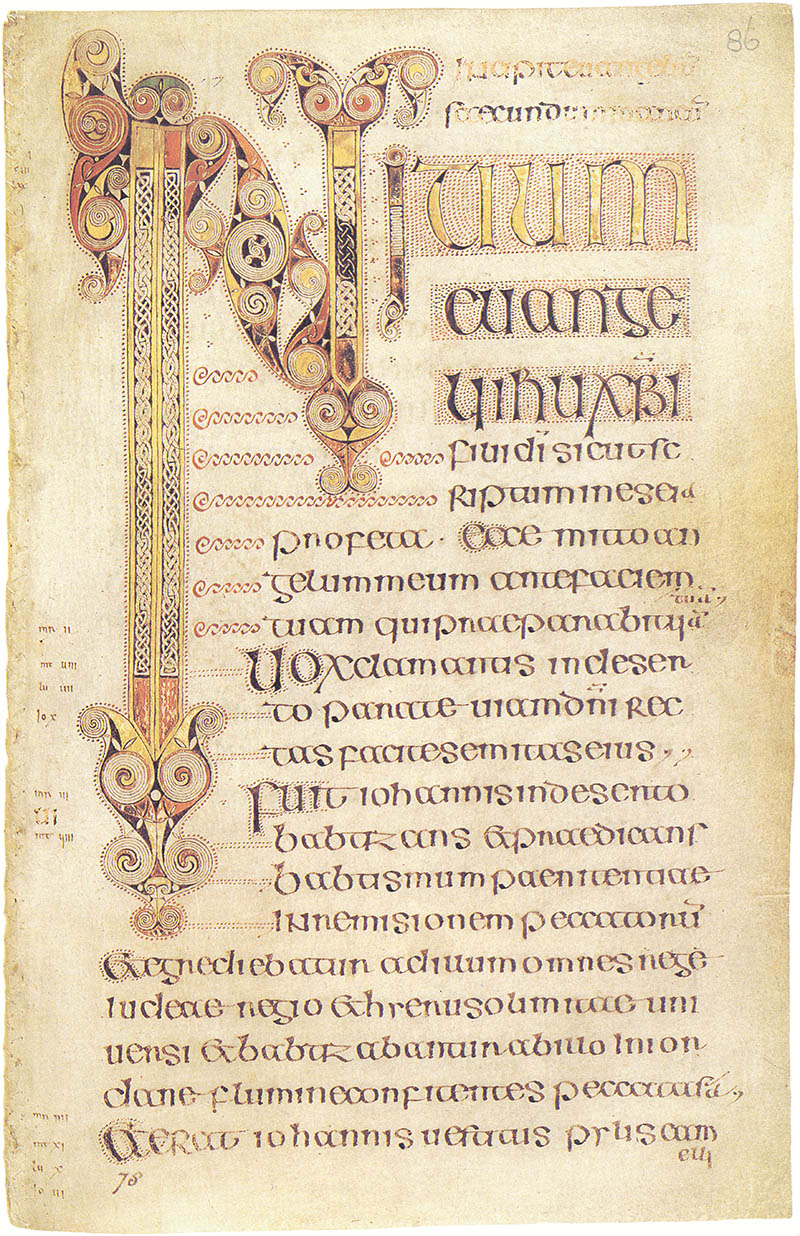 Beginning of the Gospel of Mark. Beginning of the Gospel of Mark.Book of Durrow Abbey, Trinity College in County Laois, Ireland.Dublin, VII century. |  Book of Kells - Gospel of Kells Abbey. Page 34r. Monogram Hiro (χρ) - first letters of the name of Christ, 800 A.D. Trinity College, Dublin, Ireland. | 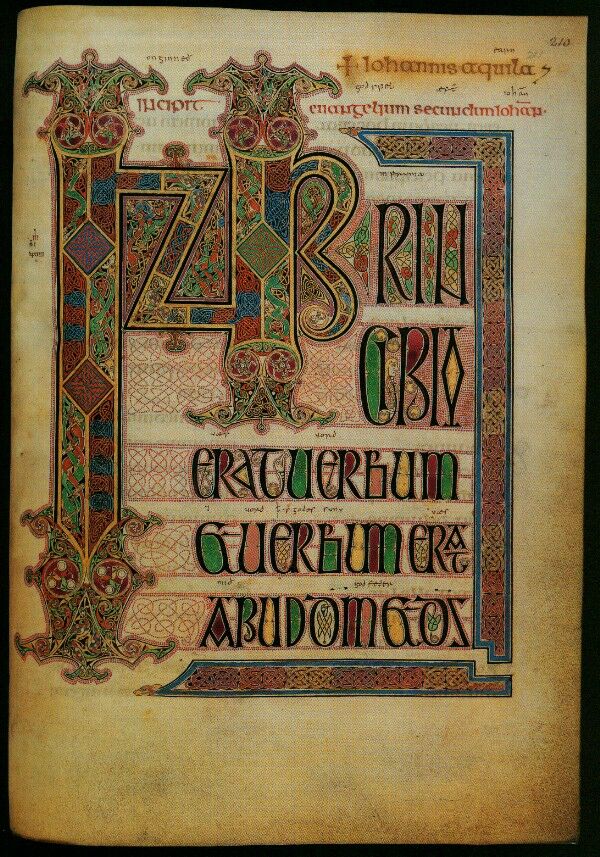 Lindisfarne Gospels, Lindisfarn Priory in Northumbria, end of the VII-VIII century. British Library, London |
Meanwhile, after the year 800, when Civilization Christianity started to dominate Western Europe, Irish Orthodox Christianity went into the depths of European culture and, even in a somewhat dormant state continued to exert a major influence on the development of Western European Christianity.
After inventing the compass the Vikings were able to navigate on the open seas without seeing land, giving them the ability to appear suddenly on almost any point of the coastline of continental Europe. Penetrating the continent along the rivers, they made sudden pinpoint strikes, thus enabling them to bring to their knees any European state of that time. In 911 the king of the Western Frankish kingdom, Charles the Simple, understood that he lacked the means to defeat the Vikings, so he entered into the treaty of St. Clair-sur-Ept with their leader, Rollo, who was known at the time as “Hrolf the Pedestrian” because he was a giant too heavy for a horse to carry. According to this treaty, the Norman coast and surrounding mouth of the Seine down to Rouen became his fiefdom on the condition that he would be baptized. After the former murderer and pirate Hrolf the Pedestrian became Christian, he also became an effective and just ruler, establishing law and strict justice.
When some people accept Christ genuinely, they often express in works of art the impression made upon them by his beauty. Thus the son of Rollo, William the Long Sword, after his capture of the Kotenten Peninsula in 933, celebrated this victory by sponsoring the construction of the Abbey devoted to Archangel Michael on Mont-Saint Michel - the first church of Norman architecture and the direct predecessor of Gothic architecture, which explicitly demonstrated the important element of the Gothic arch.
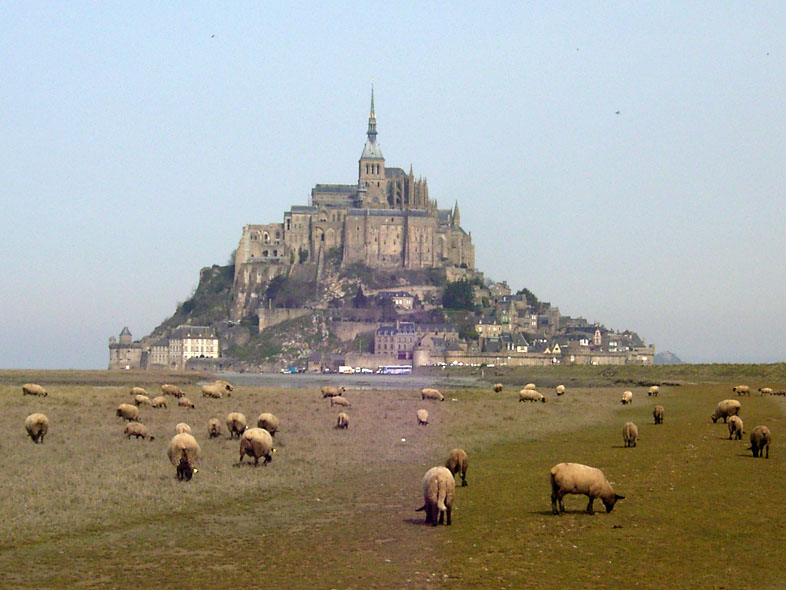 Mont-Saint-Michel. |  The first Carolingian Church. Notre Dame sous Terre. Church of the Virgin under the ground. |
When the father of Richard I, William the Long Sword, was treacherously murdered in 942, Richard was taken hostage by the French king, Louis IV in violation of the treaty of St.-Clair-sur-Ept. The relatives of Richard asked for help from the king of the Danes, Harald Bluetooth. The Danes forced the French king to set Richard free, and immediately thereafter Richard began to make a significant investment in the abbey of Mont-Saint Michel, which, according to the “Golden Legend,” was the location of the finale of the battle of the Archangel Michael with Satan in the guise of a dragon, which had begun on the Mount of Gargana. On the other hand, it was Richard I who, fearing the connections of the monks of the Gallo-Roman community of St. Aubert with Breton, dissolved this community and brought Benedictines into the Abbey of Mont- Saint Michel, along with their own abbot Mynar (Maynard). Abbot Mynar, as the head of Mont-Saint Michel, became famous as a tireless collector of libraries. It is known that he gathered in the Abbey of Mont-Saint Michel almost the entire library of the Alcuin Academy in Aachen, including Alcuin’s personal archive. The list of books from this library is absolutely amazing because it refers to books that even in those days were considered to be lost. The archive of Alcuin is particularly important, as it is practically the sole source of knowledge about this intellectual center of Civilization Christianity. Alcuin himself originally belonged to the Irish spiritual tradition, and for that reason he was very reluctant to join the intellectual community assembled by Charlemagne in Aachen, whose members became the architects of Civilization Christianity. However, Charlemagne managed to convince Alcuin to come to Aachen, so that he would join the group of intellectuals invited by Charlemagne at the time they were beginning to develop the so-called “Germanic theology” and preparing for the Frankfurt Council. Alcuin was charmed by Charlemagne and found out that this “illiterate martinet” was actually a leader and personal friend the most brilliant intellectuals of Europe at that time, scientists and artists whom Charlemagne had gathered in Aachen for the purpose of restoring the ancient civilization and the Roman Empire. One should not lose sight of the fact that Alcuin himself was a famous scientist and mathematician, who independently created the foundation of mathematical logic and graph theory over 1000 years ago. The effect created by the Alcuin Academy in Aachen cannot be overemphasized.
Of course, it is not surprising that the 25-year old Richard I was trying to recreate in the Abbey of Mont-Saint Michel the intellectual center of Charlemagne, because in doing so he imitated the great victor of Poitiers, whose persona had a way of hypnotizing all the conquerors of Europe, from Frederick Barbarossa to Adolph Hitler. It is surprising that such a young man was able to understand how military force could be derived from the power of knowledge, and began to imitate Charlemagne as a civilization builder.
In 961, Richard I, in connection with a new attack by the French king, was again obliged to call on Harald Bluetooth. The militant fellowship between Christian Richard, and pagan Harald definitely contributed to conversion to Christianity of the Danes. Harold Bluetooth and his people were baptized in 965 by a monk called Popo from the Frisian Annegrey monastery founded by St. Columban. This event marked the beginning of the domino effect that resulted in the conversion to Orthodoxy of all Normans from Kiev to the British Isles.
 It is extremely interesting that Harald Bluetooth of Denmark documented the circumstances of his baptism by Irish Orthodox Christians (rather than Civilization Christians) by inscribing them on the runic stone in Jelling, which he had erected in honor of his parents. The fact that even in 1096 the official historian of Civilization Christianity, Adam of Bremen, tried to explain these events as a consequence of the victory of the Holy Roman Emperor Otto II over the Danes, only confirms the fact that people tend to judge others by themselves and proves by contradiction that his method of interpreting history has no substance whatsoever.
It is extremely interesting that Harald Bluetooth of Denmark documented the circumstances of his baptism by Irish Orthodox Christians (rather than Civilization Christians) by inscribing them on the runic stone in Jelling, which he had erected in honor of his parents. The fact that even in 1096 the official historian of Civilization Christianity, Adam of Bremen, tried to explain these events as a consequence of the victory of the Holy Roman Emperor Otto II over the Danes, only confirms the fact that people tend to judge others by themselves and proves by contradiction that his method of interpreting history has no substance whatsoever.In 977, St. Vladimir, the future Baptist of Russia, while still a pagan, arrived in Norway to seek support from his cousin, King Haakon the Mighty. The latter at that time was at war with his suzerain Harald Bluetooth, in connection with the attempt of Harald Bluetooth to baptize Norway, including Haakon. Ironically, the baptizer of Norway, Olaf I Tryggvason, who grew up in the house of St. Vladimir, killed was the one who killed Haakon the Mighty. Curiously, Olaf Tryggvason and St. Vladimir permanently parted with each other in Novgorod in 981 as pagans, but independent of each other became Christians more or less simultaneously ten years later. Vladimir the Saint met Christ in the Crimea, impressed by the beauty of Hagia Sophia, while Olaf was baptized by an Irish monk on the island of Scilly, yearning for the beauty of his suddenly deceased wife.
After the baptism of the Danes and Norwegians, the Normans’ talent for state building became fully apparent. Canute the Great, the grandson of King Harald Bluetooth, conquered England in 1016 and immediately put down all quarrels between the different ethnic groups of England, codified English law and created the financial system of England by organizing the minting of coins. He strongly contributed to the Christian education of England and Denmark, and his son Hardeknund brought back from exile to England his half-brother Edward the Confessor, who is now locally venerated as a saint by the community of Sourozh of the Russian Orthodox Church. St. Edward the Confessor was related through his mother, Emma of Normandy, to William the Conqueror, the founder of the British monarchy and the grandson of Richard I..
It should be noted that the state-building talents of the Duke of Normandy, William the Conqueror, were supported not only by the Papacy but by his monastery of Mont-Saint-Michel, which consequently in 1066 became a major intellectual center for Civilization Christianity, and became for the Normans to self-identify.. The conquest of England by the militant union of Normans and Civilization Christianity became a prototype for not only the “Baussant” over Jerusalem, but also of the “Union Jack” over the Suez Canal and “Old Glory” on the Moon. The cold, rational cruelty of the Norman conquest of England and its engineered style fundamentally distinguishes it from Berserker rage and was a sign of a new type of civilization – the Anglo-Norman monarchy. The subsequent history showed that Anglo-Norman monarchy, while not actually a part of continental Europe, managed to surpass Europe in the Europeanization of the rest of the world. An analysis of the reforms of William the Conqueror and his methods of suppressing the resistance in York proves that the “Doomsday Book” was pregnant with the Internal Revenue Service and Federal Reserve System, while the Devastation of the North was pregnant with racial slavery and the genocide of Native Americans. Nevertheless, the prototype reflected a potency rather than reality.
 Bayeux Tapestry. | 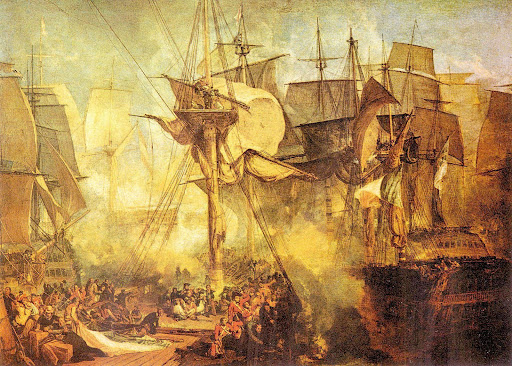 Battle of Trafalgar. Mellord Joseph Turner. 1806. |
Fortunately, in spite of the fact that the paradigm of Norman civilization changed, so that in the Doomsday Book one can find only three wealthy Saxons, the same Normans showed themselves to be completely different a few year later when they began the conquest of Ireland. Conquest never leaves pleasant memories; however, the very fact that the Norman conquerors caused the idiom “Níos Gaelaí ná na Gaeil iad féin” (“More Irish than the Irish themselves”) to appear in the language of the conquered says that the Normans at that time had not yet lost the potential to build a multi-national state. This allowed them to make a significant contribution to the establishment of the Orthodox Empire on the eastern end of the continent.
 Bayeux Tapestry. |  Christ Pantocrator Aberdeen_Bestiary. |

 Do not forget that for thirty-six years before the Norman conquest of England, in Norway, the homeland of the Vikings, St. Olaf, the last saint of the unified Church, managed to fulfill his mission as a pacifier and unifier of the people, putting down a bloody civil war. St. Olaf became the object of veneration and love by protecting Christianity, which arose in Norway as a religion of the peasants, from pagan nobility who were supported by the invading army of the Danes. Escaping death, he fled with his son Magnus, first to Sweden and later to Novgorod in the newly baptized Kievan Rus as his childhood sweetheart Swedish princess Ingegerd, married the Kievan Prince Yaroslav the Wise. On her insistence, Yaroslav adopted St. Olaf’s son Magnus, Meanwhile, St. Olaf returned to Norway as Christians there became victorious and proclaimed him King. Later, he was murdered by rebellious jarls and Danish invaders, but when Danish king Canute the Great died five years later, the people’s love for St. Olaf caused them to proclaim his son, Magnus the Noble, King of Norway and Denmark. This completed the process of the Christianization of the Vikings and brought to Scandinavia a 200-year golden age of peace and prosperity.
Do not forget that for thirty-six years before the Norman conquest of England, in Norway, the homeland of the Vikings, St. Olaf, the last saint of the unified Church, managed to fulfill his mission as a pacifier and unifier of the people, putting down a bloody civil war. St. Olaf became the object of veneration and love by protecting Christianity, which arose in Norway as a religion of the peasants, from pagan nobility who were supported by the invading army of the Danes. Escaping death, he fled with his son Magnus, first to Sweden and later to Novgorod in the newly baptized Kievan Rus as his childhood sweetheart Swedish princess Ingegerd, married the Kievan Prince Yaroslav the Wise. On her insistence, Yaroslav adopted St. Olaf’s son Magnus, Meanwhile, St. Olaf returned to Norway as Christians there became victorious and proclaimed him King. Later, he was murdered by rebellious jarls and Danish invaders, but when Danish king Canute the Great died five years later, the people’s love for St. Olaf caused them to proclaim his son, Magnus the Noble, King of Norway and Denmark. This completed the process of the Christianization of the Vikings and brought to Scandinavia a 200-year golden age of peace and prosperity.St. Olaf is considered not only to be the patron of the kings of Norway, but also of sculptors, as he was a sculptor himself. The veneration of St. Olaf created an entirely new liturgical art– wooden sculpture iconography. Iconographic sculpture spread rapidly not only in Norway but also in Normandy, Russia and Byzantium, as a large number of Vikings served in these countries in the army and as Imperial guards of the Palace.
 It is not surprising that around that time in all these countries there appeared many sculpted icons. What is surprising is that in 1923, when N.N. Serebrennikov discovered in the Perm Region in the north of Russia the centuries-old artistic tradition of wooden sculpture of Orthodox saints, somehow it was attributed to the Komi-Permian pagan tradition. Specifically, the credit went to a so-called “Golden Baba” – the idol of the Komi people, which recently caused an appearance of a large amount of pop literature in modern Russia. Of course, the Golden Baba existed, and it even lent its name to one of the Finno-Ugric peoples – the Zyryane (in Komi language “golden baba” sounds like “Zarni ani”). Meanwhile, the only reliable description of the Golden Baba (Zarni ani) is a Norwegian saga about an expedition to Biarmia (Perm) in 1023 to purchase furs, which was headed by Thorer the Hound, the eventual assassin of St. Olaf. This saga actually describes how Thorer the Hound stole this golden idol and melted it, and that alone proves that this golden statue could not be the origin of the tradition of scultped icons. Quite to the contrary, it proves that a close cultural interaction existed between the Vikings of Norway and the Komi tribes and that the origin of the Komi-Perm sculpted icons comes from the sculpted icons of Norway, originated by the followers of St. Olaf. Indeed, it is quite natural to hypothesize that the Vikings brought to Biarmia not only sculptures, but Christianity too.
It is not surprising that around that time in all these countries there appeared many sculpted icons. What is surprising is that in 1923, when N.N. Serebrennikov discovered in the Perm Region in the north of Russia the centuries-old artistic tradition of wooden sculpture of Orthodox saints, somehow it was attributed to the Komi-Permian pagan tradition. Specifically, the credit went to a so-called “Golden Baba” – the idol of the Komi people, which recently caused an appearance of a large amount of pop literature in modern Russia. Of course, the Golden Baba existed, and it even lent its name to one of the Finno-Ugric peoples – the Zyryane (in Komi language “golden baba” sounds like “Zarni ani”). Meanwhile, the only reliable description of the Golden Baba (Zarni ani) is a Norwegian saga about an expedition to Biarmia (Perm) in 1023 to purchase furs, which was headed by Thorer the Hound, the eventual assassin of St. Olaf. This saga actually describes how Thorer the Hound stole this golden idol and melted it, and that alone proves that this golden statue could not be the origin of the tradition of scultped icons. Quite to the contrary, it proves that a close cultural interaction existed between the Vikings of Norway and the Komi tribes and that the origin of the Komi-Perm sculpted icons comes from the sculpted icons of Norway, originated by the followers of St. Olaf. Indeed, it is quite natural to hypothesize that the Vikings brought to Biarmia not only sculptures, but Christianity too.  The failure of the Soviet art historians who discovered the wooden sculptures of Christian saints in Perm to connect this tradition with the Norwegian of sculpted iconography is inexplicable – until you find out that one of these discovers was Igor Grabar, and that they made this discovery while watching members of the Young Communist organization burn these sculptures. Aye, there’s the rub. For who in the time of the Bolsheviks’ crusade against Christianity needed to establish this kind of connection? It goes without say that the last thing that Igor Grabar needed was to establish a cultural connection between the brilliant Perm sculptures and St. Olaf of Norway, as well as proof of the fact that the Christianization of Rus came not only from Byzantium but through Norway and Great Perm too. Another Holy Lie?
The failure of the Soviet art historians who discovered the wooden sculptures of Christian saints in Perm to connect this tradition with the Norwegian of sculpted iconography is inexplicable – until you find out that one of these discovers was Igor Grabar, and that they made this discovery while watching members of the Young Communist organization burn these sculptures. Aye, there’s the rub. For who in the time of the Bolsheviks’ crusade against Christianity needed to establish this kind of connection? It goes without say that the last thing that Igor Grabar needed was to establish a cultural connection between the brilliant Perm sculptures and St. Olaf of Norway, as well as proof of the fact that the Christianization of Rus came not only from Byzantium but through Norway and Great Perm too. Another Holy Lie?Of course, we must thank God and Igor Grabar that all these masterpieces of liturgical art were saved for Russia, but our time of total seizure by paganism and dualism of each and every space from which Orthodox Christian teaching was expelled requires immediate clearing of the semantic debris and reversal of the cultural consequences of this “holy lie.”
© Alexander Brodsky


No comments:
Post a Comment